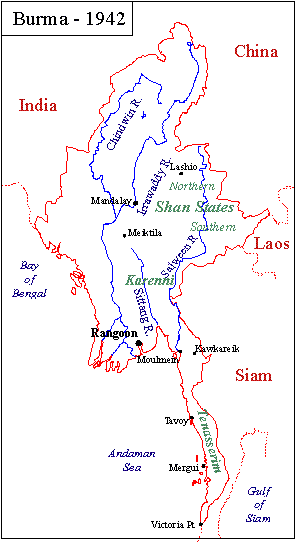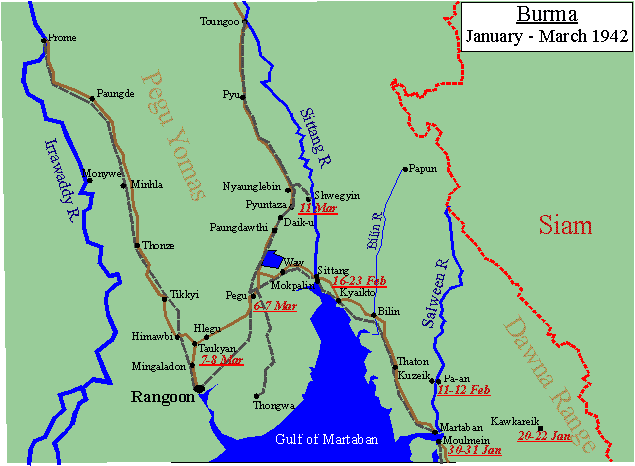The Japanese Invasion of Burma
See: Actions - 1942 for a summary of the significant actions and engagements of the Japanese invasion and the British retreat.
First Actions and the Loss of Rangoon
The first Japanese ground action against Burma was in December 1941, when a battalion of the 143rd Infantry Regiment of the 55th Division crossed the Burma-Siam border and seized Victoria Point, the most southerly extremity of Tenasserim, on 16th December. The first air raids on Rangoon occurred on 23rd and 25th December, and were opposed by only two fighter squadrons - 16 P40s of the American Volunteer Group (AVG) and 16 Buffaloes of the Royal Air Force.
 These initial actions followed by a lull as the Japanese organised themselves for the invasion proper from across the border with Siam. On 23rd December 1941, General Wavell flew to Chungking to discuss the war situation and to ask for specific help from the Chinese Government. Keen to defend their supply line, the Burma Road, the Chinese offered their Fifth and Sixth Armies for the defence of Burma. These Chinese forces were to be under the command of the General Officer Commanding (G.O.C.), Burma Army but with their own line of communications. Subsequently, the arrival of Chinese troops in north eastern Burma resulted in the diversion of officers and civil administrators to ensure effective liaison between the Chinese and the British, and to arrange local supplies for the Chinese, mitigating the worst of their depredations against the Burmese population.
These initial actions followed by a lull as the Japanese organised themselves for the invasion proper from across the border with Siam. On 23rd December 1941, General Wavell flew to Chungking to discuss the war situation and to ask for specific help from the Chinese Government. Keen to defend their supply line, the Burma Road, the Chinese offered their Fifth and Sixth Armies for the defence of Burma. These Chinese forces were to be under the command of the General Officer Commanding (G.O.C.), Burma Army but with their own line of communications. Subsequently, the arrival of Chinese troops in north eastern Burma resulted in the diversion of officers and civil administrators to ensure effective liaison between the Chinese and the British, and to arrange local supplies for the Chinese, mitigating the worst of their depredations against the Burmese population.
In early January 1942, General Hutton, G.O.C. Burma Army Command since 27th December, prepared an assessment of the situation in Burma, in which he recognised the vulnerability of the strategic port of Rangoon. He ordered the stocking of a series of depots in Upper Burma in the area Mandalay-Meiktila as a backstop. The defence of northern Tenasserim would centre on Moulmein and was the responsibility of the 17th Indian Infantry Division, which eventually had four infantry brigades under command. To the north, the Shan States and Karenni would be defended by the 1st Burma Infantry Division and the Chinese 227th Regiment.
Meanwhile, the Japanese 15th Army had completed its preparations for invasion. The 55th Division finished its concentration at Raheng, Siam, at the beginning of January 1942. There it was joined by the 33rd Division around 10th January and work began to improve communications to the frontier. The 3rd Battalion, 112th Infantry Regiment (III/112 Battalion) crossed the frontier on 15th January and captured the town of Tavoy with its airfield on the 19th, forcing the evacuation of the Mergui garrison to Rangoon the next day. The Japanese now had the three airfields from which to fly fighter escorts for the bombers attacking Rangoon; Victoria Point, Tavoy and Mergui,
On 21st January, a larger scale attack by the 55th Division forced the withdrawal of the 16th Indian Infantry Brigade from the Kawkareik position. The subsequent defence of Moulmein was stubborn if short and a further withdrawal on 31st January, across the Salween estuary by river steamer to Martaban, was brilliantly handled. It was then hoped that the Japanese could be held on the Salween but the enemy crossed the river and established a roadblock north of Martaban. The Martaban garrison was thus forced to withdraw on 9th February. At Kuzeik, the 7th Battalion,10th Baluch Regiment was all but destroyed on 11th February. Further Japanese pressure produced another withdrawal, this time to the Bilin River, where once again it was hoped to make a stand.
In the first major action of the campaign, the 17th Indian Infantry Division was practically destroyed. The Bilin River position was attacked by both the Japanese 33rd and 55th Divisions and the 17th Indian Infantry Division, after four days defence, began a withdrawal to the Sittang River on the night of 19th/20th February. The Japanese hoped to outflank the withdrawal and reach the only crossing over the Sittang River, the railway bridge, first. Disaster struck the retreating Indian Division - on the morning of 23rd February, the bridge was blown prematurely, leaving most of the troops and equipment on the wrong side of the river. Some 3,300 men successfully crossed the river by any means available, leaving all their equipment behind. These survivors were pulled back to Pegu to reorganise.
 The defence of the southern sector of the Sittang Valley now devolved to the newly arrived British 7th Armoured Brigade, which deployed literally straight off the ship from Egypt. The area higher up the Sittang Valley was defended by two weak brigades of the 1st Burma Infantry Division, the 13th Indian Infantry Brigade being left in the Karen Hills covering crossing points over the Salween. The 1st Burma Infantry Division had been relieved of its responsibilities for defence of the Shan States by the Chinese Sixth Army. By the end of February, the Chinese had taken over responsibility for the Southern Shan States, were taking over in Karenni and had agreed to defend the Sittang Valley around Toungoo. Chinese deployment had been slow, partly because of British tardiness in taking up the Chinese offer, on the assumption of further British and Commonwealth reinforcements, and partly because of the difficulties in concentrating and moving the Chinese armies.
The defence of the southern sector of the Sittang Valley now devolved to the newly arrived British 7th Armoured Brigade, which deployed literally straight off the ship from Egypt. The area higher up the Sittang Valley was defended by two weak brigades of the 1st Burma Infantry Division, the 13th Indian Infantry Brigade being left in the Karen Hills covering crossing points over the Salween. The 1st Burma Infantry Division had been relieved of its responsibilities for defence of the Shan States by the Chinese Sixth Army. By the end of February, the Chinese had taken over responsibility for the Southern Shan States, were taking over in Karenni and had agreed to defend the Sittang Valley around Toungoo. Chinese deployment had been slow, partly because of British tardiness in taking up the Chinese offer, on the assumption of further British and Commonwealth reinforcements, and partly because of the difficulties in concentrating and moving the Chinese armies.
Hopes of reinforcement by the Australian 7th Infantry Division, returning from Egypt to defend Australia, were dashed when the Australian government decided against allowing the Division to be diverted to Burma. The only available reinforcements in prospect were the partially trained 63rd Indian Infantry Brigade, an Indian field regiment and three British battalions. The convoy carrying the 63rd Indian Infantry Brigade and the artillery was diverted to Calcutta by General Hutton, who wished to evacuate Rangoon early. He was overruled by Wavell, who ordered that Rangoon be held at least until the arrival of the reinforcements. Hutton was replaced by General Alexander, who arrived in Rangoon by air on 3rd March. The reinforcements arrived the same day.
The Japanese advance had been delayed by the need to bring up heavy equipment to provide an adequate crossing over the Sittang River. Despite heavy fighting around Pegu on 6th and 7th March, the Japanese succeeded in moving through the gap between the defenders of Pegu and 1st Burma Infantry Division. The Japanese saw an opportunity to capture Rangoon quickly, from where the British were now hastily evacuating all remaining personnel. The 17th Indian Infantry Division, with the 7th Armoured Brigade under command, was to hold the Hlegu area until the withdrawing Rangoon garrison had left Taukkyan. However, the Japanese got there first and established a roadblock near Taukkyan and there was fierce fighting to clear this on 7th and 8th March. The Rangoon garrison got away however, having carried out thorough demolitions, when the Japanese withdrew their roadblock to concentrate for the capture of the city, thinking that the garrison was still there. Around midday on 8th March, the 215th Infantry Regiment of the Japanese 33rd Division entered Rangoon and was surprised to find the city deserted.
03 December 2017